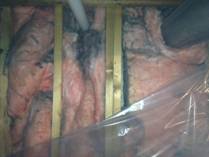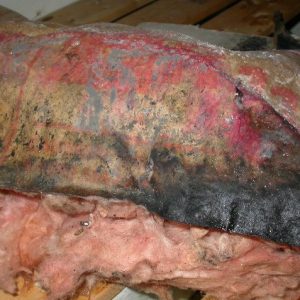The vast majority of homebuilders, renovators, contractors and homeowners have a socially constructed misconception about insulation in basements. This misconception is not just the installation process, but also the products being used. Insulating and finishing your basement is one of the key ways to lowering your energy bills, increasing the value of your home, and also providing a comfortable living space. This is widely known and accepted. However, we may think by insulating our basement with any type of insulation we will accomplish all the key points listed above. This isn’t the case.
Insulating your basement with products that are unsuitable to be in that environment seems like an obvious, and general statement. In relation, the same statement can be made for baking a cake. Baking a cake with ingredients that are not suitable for that specific recipe will result in a disappointing birthday cake.
 Battt insulation, 2X4 wood or steel stud framing, and a poly vapour barrier is commonly used practice for insulating basements throughout Canada. This however is a recipe for disaster. Batt insulation absorbs moisture; in doing so this it inherently harbors mould, and mildew. Unlike a cake, insulating your basement is a long-term investment. As consumers we would hope that a product that is designed to insulate buildings would not become hazardous and need replacement. I am not an expert on creating delicious deserts, but it seems to me it would be very challenging to extract a hazardous ingredient from a freshly baked cake. Then why would we install a product in our homes and buildings that will ultimately need to be replaced in the wall assembly?
Battt insulation, 2X4 wood or steel stud framing, and a poly vapour barrier is commonly used practice for insulating basements throughout Canada. This however is a recipe for disaster. Batt insulation absorbs moisture; in doing so this it inherently harbors mould, and mildew. Unlike a cake, insulating your basement is a long-term investment. As consumers we would hope that a product that is designed to insulate buildings would not become hazardous and need replacement. I am not an expert on creating delicious deserts, but it seems to me it would be very challenging to extract a hazardous ingredient from a freshly baked cake. Then why would we install a product in our homes and buildings that will ultimately need to be replaced in the wall assembly?
For the sake of argument lets say batt insulation, when installed in the perfect wall assembly cannot absorb moisture, support mildew, or grow mould. Well then at least we have a product that insulates buildings and in doing so we are saving money on our energy bill. Right?
As it turns out the National Research Council of Canada and the Building Science Consortium has conducted a plethora of research into understanding thermal resistance. It turns out that there is (or was) a vast misunderstanding of how effective a “Nominal R-value” is. Therefore, Building Scientists have developed a new way to measure thermal resistance, which is appropriately titled “Effective R-value”. The difference between Nominal R-value and Effective R-value (in laymen’s terms) is not just how well the specific insulation product performs on an individual thermal resistance level, but how well the entire assembly performs in real world conditions.
To drive home this idea I will make use of the cake analogy again. A cake isn’t measured by just how “sweet” the cake is. A good cake must also be moist, fresh, and have some attractiveness to it. A good cake, just like a basement insulation system, is not just measured by one component – but in its entirety.
Another common practice used in the basement industry is the application of Spray Foam on the interior side of basement walls, hopefully with the wood/steel stud framing off the concrete to eliminate Thermal Bridging. Spray foam itself has a high effective R-value and is considered amongst many to be one of the best insulation products for basement applications. In some cases this is a hard point to argue.
However, Spray Foam Insulation has a tendency to off gas from the chemicals that are fundamental in manufacturing and producing Spray Foam. This is why Spray Foam installers have a striking resemblance to astronauts, the protective gear they wear keeps them safe. Even though this product does have the capacity to properly insulate basements, reduce your energy costs, and increase the value of your home, does it actually provide an environmentally safe living space?
 As stated before having a delicious cake isn’t just about having a “sweet” cake there are many other factors involved. However, sweetness being one of the more important conditions from a cake eater standpoint, then the “sweetness” ingredient must provide the exact flavor we crave. Yet, it seems very unlikely that we would add antifreeze into our recipe. Antifreeze is a sweet substance that may make this the most delicious cake ever! Then again, antifreeze is also rather poisonous and could make someone very ill. I have a funny feeling that even though this ingredient may work well to provide the taste we desire, it would also be an ingredient that bakers would advise against. We wouldn’t try a food that could have poison in it, then why would we decide to live in an environment that may also be hazardous.
As stated before having a delicious cake isn’t just about having a “sweet” cake there are many other factors involved. However, sweetness being one of the more important conditions from a cake eater standpoint, then the “sweetness” ingredient must provide the exact flavor we crave. Yet, it seems very unlikely that we would add antifreeze into our recipe. Antifreeze is a sweet substance that may make this the most delicious cake ever! Then again, antifreeze is also rather poisonous and could make someone very ill. I have a funny feeling that even though this ingredient may work well to provide the taste we desire, it would also be an ingredient that bakers would advise against. We wouldn’t try a food that could have poison in it, then why would we decide to live in an environment that may also be hazardous.
In conclusion, we as homeowners and consumers need to be aware of the products we use and install in our homes. The products above are examples provided to show how we need to expand our knowledge and understand the investments we make in our homes. This is in no way an attempt to dismantle and tarnish other products reputations; the products above do have uses in other applications. It is about understanding the many products that exist and installing them in the correct assembly. This will ensure a safe, comfortable, energy-efficient living space for everyone to sit around and enjoy a delicious piece of cake.

